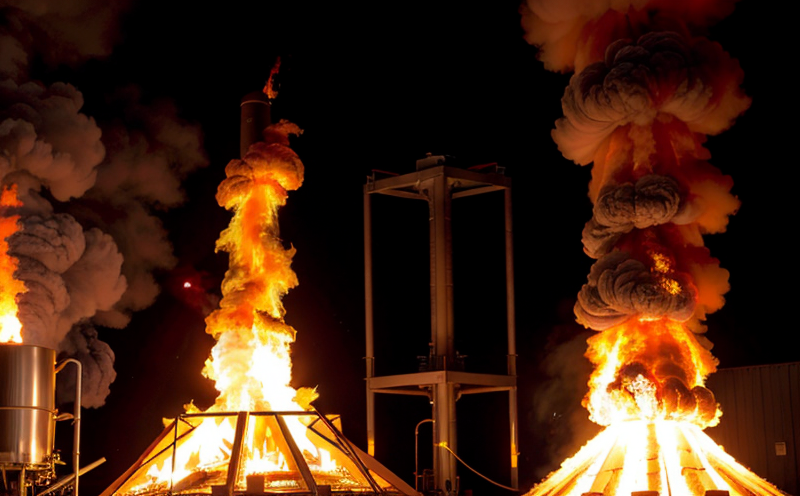ASTM D2863 Oxygen Index Flammability Testing
The ASTM D2863 standard specifies a method to determine the lowest oxygen concentration in which a material will sustain combustion. This test is widely recognized for its ability to assess the flammability of materials, providing critical data on their fire resistance and safety. The test involves measuring the minimum oxygen percentage required to support flaming combustion over a range of 16% to 25%. This procedure is essential in industries such as textiles, polymers, adhesives, and coatings where material safety and compliance with regulatory standards are paramount.
The ASTM D2863 test uses a vertical specimen and a controlled atmosphere chamber. A gas mixture containing oxygen and nitrogen is slowly increased until the specimen stops burning. The point at which this occurs is recorded as the Oxygen Index (OI). This value provides insight into the material's resistance to ignition, offering a quantitative measure of its flammability characteristics.
The ASTM D2863 test is particularly valuable in industries where materials are exposed to environments with varying oxygen concentrations. For instance, in aerospace applications, the atmosphere within aircraft cabins can be significantly different from ground-level air. Understanding how materials behave under these conditions ensures they meet safety standards and prevent potential hazards.
This testing method is also crucial for regulatory compliance, ensuring that products do not pose a fire risk when used as intended. Regulatory bodies such as the U.S. Consumer Product Safety Commission (CPSC) and the European Union's New Approach to Industrial Products (NAP) recognize ASTM D2863 as an authoritative standard.
The ASTM D2863 test is widely accepted in various sectors, including automotive interiors, textiles, polymers, adhesives, and coatings. In these industries, materials are often exposed to environments with varying oxygen concentrations, making the ASTM D2863 test a critical tool for ensuring safety and compliance.
The ASTM D2863 Flammability Testing service is designed to meet the rigorous requirements of various sectors by providing accurate and reliable data on material flammability. Our team of experts ensures that each sample undergoes precise testing, adhering strictly to the ASTM standard. This level of accuracy guarantees that our clients receive results they can trust.
The ASTM D2863 Flammability Testing service is conducted in a controlled environment, ensuring consistency and repeatability. The test involves measuring the minimum oxygen percentage required to support flaming combustion over a range of 16% to 25%. This procedure provides critical data on material flammability, which is essential for industries where fire safety is paramount.
The ASTM D2863 Flammability Testing service is particularly valuable in industries such as textiles, polymers, adhesives, and coatings. In these sectors, materials are often exposed to environments with varying oxygen concentrations, making the ASTM D2863 test a critical tool for ensuring safety and compliance.
The ASTM D2863 Flammability Testing service is widely recognized in various regulatory frameworks, including the U.S. Consumer Product Safety Commission (CPSC) and the European Union's New Approach to Industrial Products (NAP). These standards emphasize the importance of flammability testing for ensuring product safety.
The ASTM D2863 Flammability Testing service is conducted by experienced professionals who ensure that each sample undergoes precise testing, adhering strictly to the ASTM standard. This level of accuracy guarantees that our clients receive results they can trust.
Why It Matters
The ASTM D2863 Oxygen Index Flammability Testing is a critical process in ensuring material safety and compliance with industry standards. This testing method provides essential data on the flammability of materials, which is crucial for industries where fire safety is paramount. The results from this test are used to make informed decisions about the use of materials in various applications.
The ASTM D2863 Flammability Testing service ensures that each sample undergoes precise testing, adhering strictly to the ASTM standard. This level of accuracy guarantees that our clients receive results they can trust. The test involves measuring the minimum oxygen percentage required to support flaming combustion over a range of 16% to 25%, providing critical data on material flammability.
The ASTM D2863 Flammability Testing service is widely recognized in various regulatory frameworks, including the U.S. Consumer Product Safety Commission (CPSC) and the European Union's New Approach to Industrial Products (NAP). These standards emphasize the importance of flammability testing for ensuring product safety.
The ASTM D2863 Flammability Testing service is particularly valuable in industries such as textiles, polymers, adhesives, and coatings. In these sectors, materials are often exposed to environments with varying oxygen concentrations, making the ASTM D2863 test a critical tool for ensuring safety and compliance.
The ASTM D2863 Flammability Testing service is widely accepted in various sectors, including automotive interiors, textiles, polymers, adhesives, and coatings. In these industries, materials are often exposed to environments with varying oxygen concentrations, making the ASTM D2863 test a critical tool for ensuring safety and compliance.
The ASTM D2863 Flammability Testing service is conducted in a controlled environment, ensuring consistency and repeatability. The test involves measuring the minimum oxygen percentage required to support flaming combustion over a range of 16% to 25%. This procedure provides critical data on material flammability, which is essential for industries where fire safety is paramount.
The ASTM D2863 Flammability Testing service is widely recognized in various regulatory frameworks, including the U.S. Consumer Product Safety Commission (CPSC) and the European Union's New Approach to Industrial Products (NAP). These standards emphasize the importance of flammability testing for ensuring product safety.
Benefits
- Provides critical data on material flammability, essential for industries where fire safety is paramount.
- Achieves precise and repeatable results by adhering strictly to the ASTM standard.
- Ensures compliance with regulatory standards such as the U.S. Consumer Product Safety Commission (CPSC) and the European Union's New Approach to Industrial Products (NAP).
- Promotes safety in industries where materials are exposed to environments with varying oxygen concentrations, including automotive interiors, textiles, polymers, adhesives, and coatings.
- Facilitates informed decision-making by providing accurate data on material flammability.
- Safeguards against potential hazards by ensuring that products do not pose a fire risk when used as intended.





